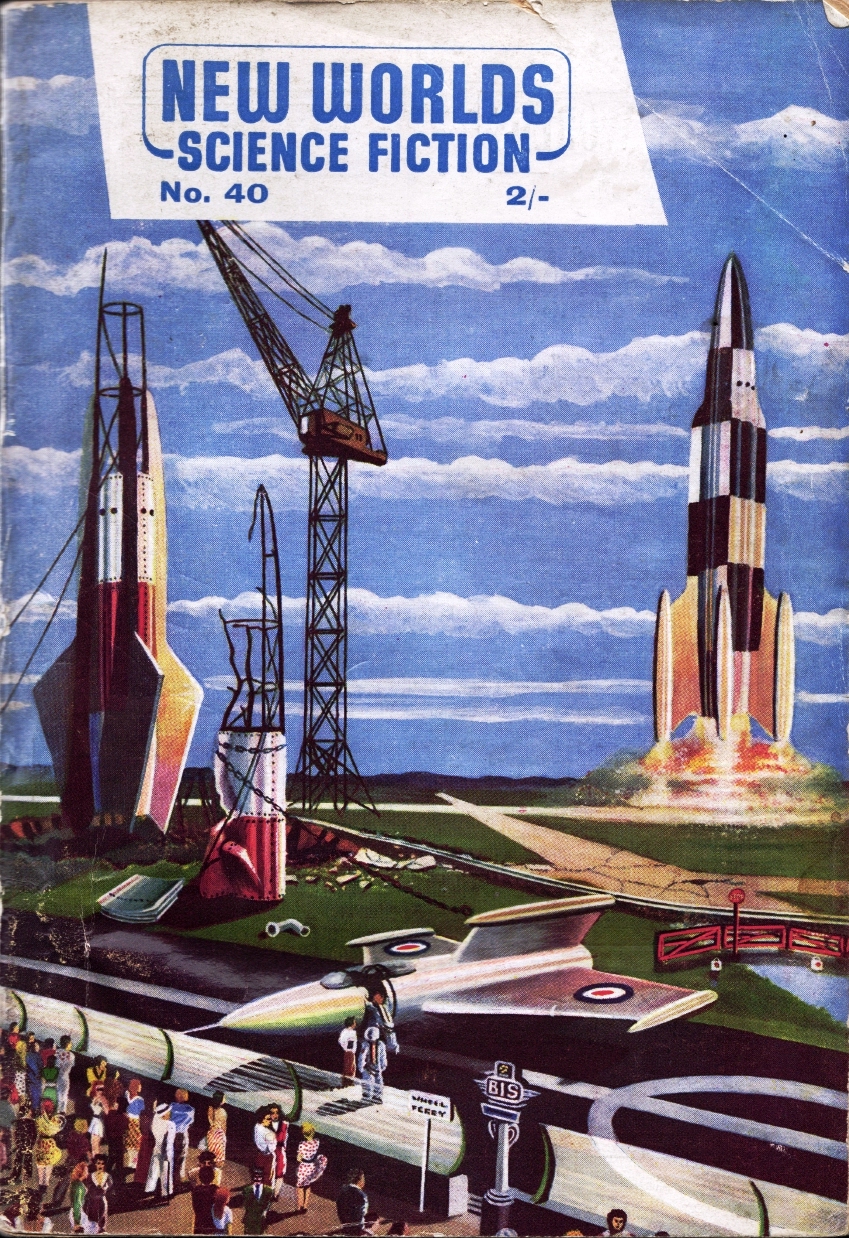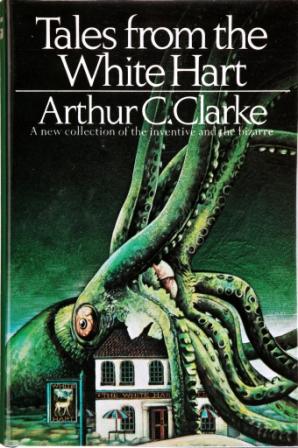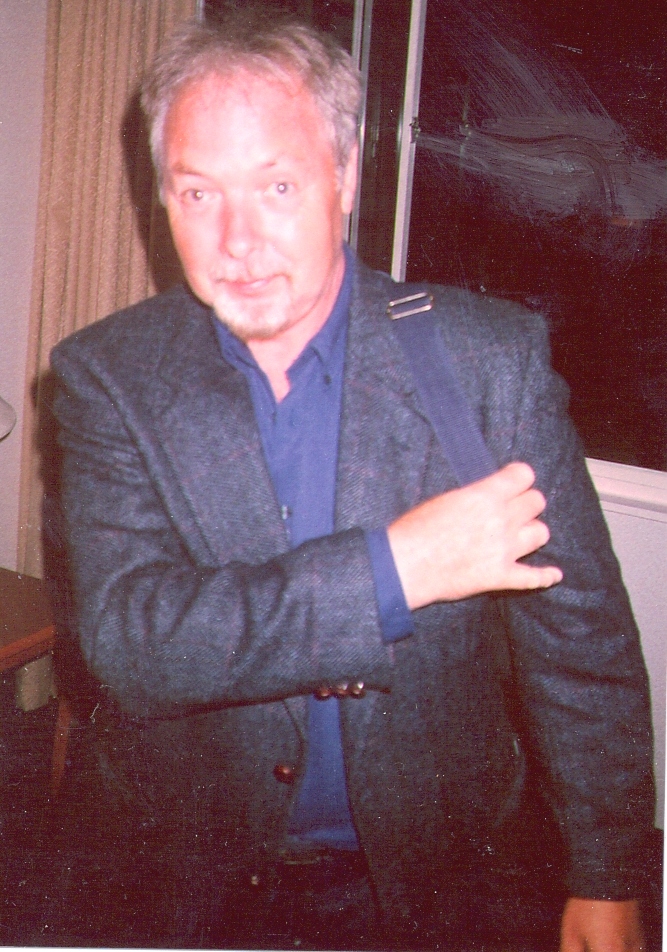New Worlds magazine revisitedNew Worlds was Britain's answer to the USA's Analog.
|
 |
You never know what is around the corner. There I was, at my local SF group, quietly enjoying a pint, when a friend brings in a copy of New Worlds magazine, issue no. 40 dating from October 1955 and this opened a window into Britain's SF scene of that time. Let me share…
Now, you would be forgiven if you have never heard of New Worlds: it finished being published as a magazine in 1979 (though several editions were subsequently, irregularly, published as paperback books – with just one as a magazine – up to 2021. Indeed, the last in 2021 was a paperback and limited hardback by the specialist publisher PS Publishing with only a small print run. 1979 was sufficiently late that though I have no recollection of seeing a copy of the magazine, I often did see it as citations on the copyright pages of SF short story anthologies and collections which I devoured from my local library over school holidays in the 1970s. Having said that, I could have seen a copy as I joined fandom in 1976 with my first con (Novacon 7) in 1977, but back then as an impoverished student, I was not that into SF magazines, though I did regularly get the colourful broad sheet Science Fiction Monthly; that publication sadly only lasted two years. (Sigh.)
Conversely, you probably will have heard of Analog (Analog Science Fact & Fiction which began in 1960 under the editorship of John W. Campbell having had a previous incarnation as Astounding Stories of Super-Science since 1930. And you are even more likely to be aware of Amazing Stories magazine edited by Hugo Gernsback after which the Hugo Awards are named. Analog's circulation peaked at over 100,000 copies.
Of course, the USA's population is roughly five times that of the United Kingdom's and so, purely on these stochiometric grounds, the US population is more able to sustain a specialist magazine circulation: nonetheless, New Worlds circulation reached 18,000 by 1951.
So, lets have a quick look at the issue 40, October 1955 edition edited by John Carnell.
It was priced at two shillings (2/-) which is numerically equivalent to 10p in today's decimalised money but in real terms – allowing for inflation – equivalent to £3.30p in 2024. So, what did you get for your 10p / £3.30p?
New Worlds contents issue 40.
Short stories:
'The Con Game' by Lan Wright
'Storm Head' by Francis G. Rayer
'Rock 83' by Alan Barclay
'Little Girl Lost' by E. C. TubbSerial:
'The Time Masters part 2 of 3 by Wilson TuckerArticles:
Timeslip film review
'Celestial Debris' by John NewmanFeatures:
Editorial by John Carnell
Book Reviews by Leslie Flood
Contents & contributors
You'll guess from the links, or lack thereof, that not all the above contributors are well known today. From the introduction to his story, Lan Wright is cited as being a previous contributor to the magazine, indeed he might have been a regular and does have a Wikipedia entry and also one in the SF Encyclopaedia. Additionally, John Carnell, Leslie Flood and E. C. Tubb have entries in both Wikipedia and the SF Encyclopaedia (sadly, to our shame, I see we (SF² Concatenation) did not record Ted Tubb's passing in 2010).
Lan Wright's story concerns a primitive alien race discovered by a more advanced (similar to Earth's humans) that seems to have a mysteriously advanced teleportation technology…
Ted Tubb is by far the biggest SF name in this issue of New Worlds yet I fear that many of today's SF neo-fans simply will not know of him but in the 1950s to'70s he was extremely well known: for instance, he was Guest of Honour at the 1964 Eastercon (Peterborough) and the 1970 Worldcon (Heidelberg). He was the author of over 140 novels and 230 short stories. He is arguably best known for his 33 book 'Dumarest Saga' (1967-2008) concerning Earl Dumarest who struggles to find his was back from a distant part of the Galaxy. (A theme that is, of course, the back bone of Star Trek: Voyager. The series was published in N. America as 'Dumarest of Terra'.
His other well known series is the 'FATE' run of 17 books (published in N. America as the 'Cap Kennedy' books (1973-'76). Alas only the first six have been published in Britain. All these were written under the pseudonym of Gregory Kern. And here's the thing, much of his work was written under aliases including: Gregory Kern, Carl Maddox, Alan Guthrie, Eric Storm and George Holt. He used 58 pen names, and some of these were publishers' house names also used by other authors: his Charles Grey pen name garnered quite a following. One can't but help think that had he written everything under his own name he would most likely be better known today.
The FATE books concerned Captain ('Cap') Kennedy, a Free Acting Terran Envoy (F.A.T.E.) who were given to act as judge, jury, and executioner, and the power to intervene in any situation which threatens the peace of the Terran Sphere, an interplanetary federation centred on Earth. Whether or not the FATE series helped inspire the creation of Judge Dredd is not known: 'Dirty Harry' is a known inspiration for Dredd.
I was privileged to have met the man a couple of times at the London SF Circle's One Tun phase (1974-'87) social meetings: it was a privilege but I was saddened to learn that he was extremely bored writing the Space 1999 novelisations, which did attempt to bring together episodes into some sort of narrative (much like James Blish's Star Trek novelisations).
Tubb's story in this edition of New Worlds, 'Little Girl Lost', concerns a grieving genius who still thinks his daughter is alive, and whose employers engage a psychologist to go along with the delusion so that the genius can work. You can find this story in The Best Science Fiction of E. C. Tubb (2003). The story went on to be dramatised in a segment of Night Gallery in 1972.
I was pleased to discover in the course of research for this article that Tubb's award-winning short story 'Lucifer!' (later published in a slightly revised version under the title 'Fallen Angel') was adapted for the 2022 film, 57 Seconds (trailer here) starring Morgan Freeman and Josh Hutcherson. The title 57 Seconds refers to the amount of time that the ring possessed by the protagonist sets back time.
Aside from short stories, this 1955 edition of New Worlds also contains the second part of a three-part serial, 'The Time Masters', by Wilson Tucker, better known to SF fans of the day as 'Bob'. When we jump into the middle of the story US Governmental agents are puzzled by one Gilbert Nash, a private detective, records of whom only go back to March 1940 before which he does not seem to have existed. Nash has a considerable interest in science and resides close to the Oak Ridge research facility having moved to the area before plans for the facility were drawn up. The man also, worryingly, seems to know more about critical US research than most people…
It may be that you have never heard of 'Bob' Tucker, but it was he who coined the term space opera. He was as much an SF fan as he was a professional writer and was a guest at many US science fiction conventions of the 1940s through to the 1970s. Indeed, he served on the committee of the 1940 SF Worldcon. The 2007 NASFiC (North American Science Fiction Con) – held in N. America those years when the Worldcon is held elsewhere. That 1940 convention was dedicated to him and called Tuckercon. Though he wrote a score of novels, with just a dozen being SF, perhaps his most famous was The Year of the Quiet Sun. That book made the short-lists of the Hugo, Locus and Nebula Awards in the 'Best Novel' category. His habit of using the names of friends for minor characters in his fiction led to the term 'tuckerisation' or 'tuckerism(s)'.
That Britain's New Worlds magazine could attract such notable US science fiction writers is a testimony to the publication's standing by core members of the SF community on both sides of the Pond.
 |
Non-fiction contents
In addition to the SF short stories there were other article including a science fact one by the chemist John Newman. Apparently, he was a regular science columnist for New Worlds. His article here is on meteorites and, given the pre-space probe science of the day, is a fair summary of the topic. John Newman was active in Britain's mid-20th century SF scene and was the principal organiser of the first, post-WWII Eastercon, Whitcon (1948), at the White Horse pub in London: a venue immortalised in Arthur C. Clarke's thematic collection Tales From The White Hart (1957/2007).
The editor, John Carnell, provides a review of the then forthcoming film Timeslip (trailer here) which is based on a script by Charles Eric Maine who himself was a regular short story contributor to New Worlds. The review is somewhat gushing that rails against Hollywood movies such as When Worlds Collide and Destination Moon calling for more concept and character-driven films. Though a British film, it stars the US dancer Gene Nelson (presumably to help with the film's N. American distribution) and Brit leads Faith Domerghue and Joseph Tomelty. I have seen the film and it is OK given its age but I wouldn't rave over it as Carnell does. It concerns a nuclear physicist whose brain is seven and a half seconds ahead of the present time. The science is nonsensical, so I guess that Carnell was praising the film for not using the worn tropes of spaceships and monsters so common in 1950s films.
Of interest is Leslie Flood's book review column: what were they reading back then, and are any of the titles still in print today? Edgar Pangborn's A Mirror for Observers concerns Martians living in subterranean cities on Earth having fled their dying planet thousands of years ago. It was priced at 12/6d (that’s a tad over 62 pence in decimal money or £20.50p in real terms); how times have changed. The other books are Ward Moore's Bring the Jubilee and Frederic Brown's collection Angels and Spaceships. One collection containing many of whose stories I do have (all be it spread over a couple of volumes), is A Handful of Darkness by an author of whom Flood says is "a writer who deserves to be more widely known", namely Philip K. Dick. This collection seems to contain stories many Dick fans today will find sprinkled in the first two volumes of the Underwood-Miller/Gollancz Dick collections. Leslie Flood went on to live a further half-century during which time Philip K. Dick became exceptionally well known with several of his stories adapted to film, not least Blade Runner.
Leslie Flood is the only other person who contributed to this edition of New Worlds I have actually met, and that was back in the 1970s following his book dealer, and Gollancz reader days when he had taken over the editor's SF author agency. When Leslie finally retired in 1986, he was given a special British Fantasy Award from the British Fantasy Society.
Cover & editorial
Finally, a look at the cover (see the top of this article) and the editorial. Both relate to space travel. Now, it is important to remember that October 1955 (the year and month of this edition's publication) was exactly one year ahead of the launch of the first orbital satellite, Sputnik, by the Russians. The editorial noted that the US had just announced that it planned to launch a satellite by 1957. The editorial, by John Carnell, mused that the US satellite programme could have been in a much more advanced stage than the then current news would have people believe. Such musings were actually being made in an information vacuum as the US had been keeping quiet about its rocket progress since the successful flight to 250 miles of one of its WAC Corporal sounding rocket in 1949. So by 1955 there had been over half a decade's secrecy. A year's time hence and John Carnell must have been stunned (as many back then were) by Russia's Sputnik space success as they too had been quietly working on rockets.
The edition's cover was by an artist called Bradshaw (no Christian name given) and it depicts a space port cited adjacent to London airport (which subsequently in 1966 was re-branded as Heathrow Airport). Passengers are assembling in front of a small spacecraft in the foreground which will take them to a wheel space station in orbit from where they will travel on to the Moon and planets. (Shades of 2001: A Space Odyssey, 1968. Could a 38 year old Arthur C. Clarke have seen this? Almost certainly: Clarke was on Novae Terrae's editorial board.) Note the Royal Air Force high-visibility roundel logo marking on the craft's wings. The two large craft in the background are unmanned vehicles used for ferrying supplies to the wheel space station. One had crashed on take off and is being reconstructed on the spot. Ahh, Britain's WWII 'can do' spirit.
The magazine's history
New Worlds began in 1939 having previously had a fanzine incarnation from 1936 under the title Novae Terrae. John Carnell took over as editor in 1939 and was responsible for the rebranding. But publication was sporadic up to 1949 (with no issue being produced in 1948). In 1949 it was biannual. In 1950 triannual and in 1951 it was quarterly. In 1952 it was published every other month but by April 1954 a regular monthly publication commenced and this lasted through to 1964 when Carnell left as editor. From then on there were issues with the publisher that owned the magazine. Famously, the author Michael Moorcock took over as editor. However, in 1966, New Worlds publisher's distributor went bankrupt owing the publisher a substantial sum forcing New Worlds (and its sister magazine Science Fantasy) to close. Brian Aldiss saved the day by getting literary luminaries to support him in obtaining an Arts Council grant to keep the magazine going. Alas, this good phase was not to last…
The March 1968 issue contained the third instalment of Norman Spinrad's novel Bug Jack Barron which contained some explicit salacious scenes and displayed a decidedly healthy, cynical attitude to politicians. One Member of Parliament spoke out complaining of the partial support afforded by the Arts Council grant which was subsequently withdrawn. Also W.H. Smith and John Menzies withdrew the offending issue from sale. Fortunately, there was some good news, in the end the Arts Council grant was renewed!
Aside from a few minor gaps New Worlds continued to be published on a fairly regular basis through to April 1970 after which time its publication became sporadic. Problems with the distributors and the final loss of Arts Council support.
 Charles Partington, 1997. |
Between 1971 and '76, New Worlds appeared as a paperback published by Sphere Books and then, 1978, briefly with Corgi Books. It was during this hiatus period that various Manchester-based folk published New Worlds as a prozine. Of the various Manchester-based folk associated with the publishers Savoy, was one Charles Partington who was involved on and off in the magazine New Worlds no.213-215 between 1978 to 1979. (Charles Partington, of course much later, in 1987 also printed the first edition of a little fanzine called SF² Concatenation: the web of SF connections runs down the decades.)
Thereafter, New Worlds went into a bit of a lull until 1991 when under the editorship of David S. Garnett a series of anthologies reappeared for four years as a paperback anthology from Victor Gollancz. The spring 1979 edition (no. 215) was edited by David Britton and Michael Butterworth.
In 2021, the specialist SF/F publisher, P. S. Publishing continued New Worlds as an anthology book series. Production standards for the series are high as is the cost, but alas the print runs are low. Nonetheless, if you love SF in its short story form, they are well worth seeking out.
2024 sees the 60th anniversary of when Michael Moorcock became New Worlds' editor. A new magazine edition is planned for the summer: magazine format as before (A4, saddle-stitched). A second book-format New Worlds anthology is due from PS Publishing later in the year.
Today, New Worlds does not enjoy the profile it once had. Nonetheless, it played a significant role in the development of mid-twentieth century British SF and as such deserves to be remembered.
Jonathan Cowie
[Up: Article Index | Home Page: Science Fact & Fiction Concatenation | Recent Site Additions]
[Most recent Seasonal Science Fiction News]
[Convention Reviews Index | Top Science Fiction Films | Science Fiction Books]
[Science Fiction Non-Fiction & Popular Science Books]